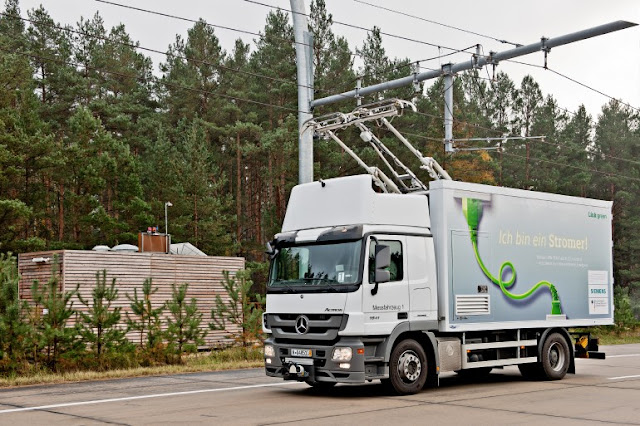Friday, June 29, 2012
Siemens tests "eHighway of the Future" vision with tram-like overhead cables
With most major auto manufacturers now actively developing electric vehicles, the drive towards a zero emission personal electric transportation future seems very much on the horizon. Road pollution doesn't just come from cars of course, freight vehicles are also major players in choking our highways and byways. Siemens is currently testing a possible solution in Germany that's based on proven railway and tram technology but has been adapted for trucks on roads. Heavy goods vehicles have been fitted with a newly-developed pantograph that can automatically raise to meet overhead cables and transfer electric power to hybrid diesel/electric power trains. Energy recovered from regenerative braking can also be fed back into the system for re-use by other vehicles.
The Siemens eHighway concept announced at the 26th Annual Electric Vehicle Symposium in Los Angeles recently is a two part system. The first involves the rollout of a two pole catenary system along one or more lanes on freight transport routes that caters for two-way electricity transmission and ensures a reliable power supply by feeding the overhead wire via container substations. The substations used in the current test project feature a medium-voltage DC switching system, a power transformer, a rectifier 12-diode array and a controlled inverter (for the feedback of the electric energy generated by regenerative braking).
Heavy goods vehicles have been fitted with a brand new pantograph - the second part of the concept - with an intelligent control system that can either automatically connect to an overhead wire upon detection by a built-in scanner or be manually controlled by the driver. Installed above the driver's cabin, the system is said to be capable of detecting the relative position of the overhead contact wire to the pantograph and counterbalances any lateral movements of the truck via active horizontal adjustment.
The test vehicles have also been retro-fitted with diesel-electric power trains, where they are always powered by an efficient electric motor but when in diesel mode, the vehicle's engine powers a generator, which in turn drives a downstream motor and turns the cardan shaft. When traveling under eHighway electric power, the vehicle is driven by the electric motor only. Siemens says that the driver is not aware of the transitions between different drive modes.
The field trial in Germany is reported to have confirmed full performance potential, independent of weather, conditions and load. The concept proved to be at least as flexible as existing fuel-based road freight transport solutions thanks to the maneuverability of the mobile pantographs, with reduction in carbon dioxide, nitrogen oxide, soot and noise pollution and added fuel efficiency benefits. Keeping up with the flow of traffic doesn't appear to have been a problem either, with speeds of up to 90 km/h (55 mph) being reached without difficulty under direct transmission of electric power.
Moving beyond the proof of concept test phase, schemes for the electrification of ports and cargo centers are already being considered but the solution has great potential for expansion to inner city roads in much the same way as streetcars/trams, and of course onto major transport routes. Naturally, such an infrastructure could also readily support the electric power needs of pure battery electrics, vehicles with range extenders, or those fitted out for compressed natural gas.
Subscribe to:
Post Comments (Atom)






No comments:
Post a Comment